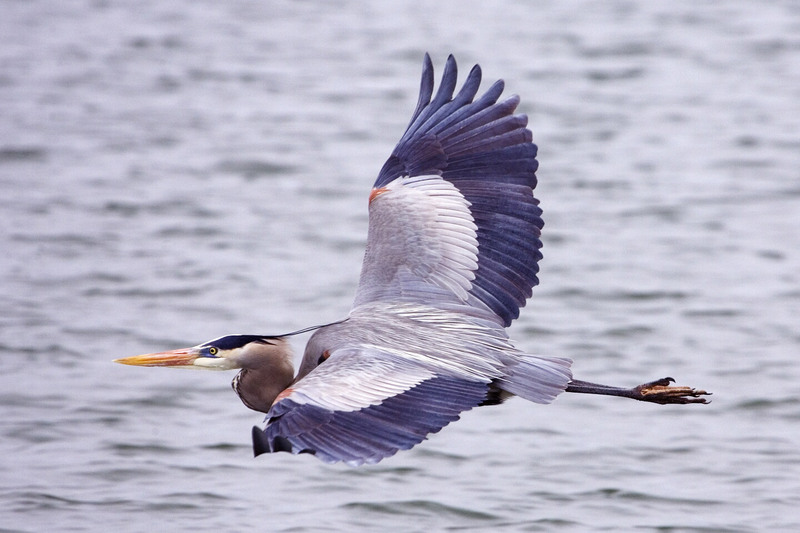|
| Query: Birds of prey | Result: 272nd of 1662 | |
Great Blue Heron (Ardea herodias) - wiki
| Subject: | Great Blue Heron (Ardea herodias) - wiki
| |

| Resolution: 1440x960
File Size: 278579 Bytes
Upload Date: 2007:08:20 08:23:07
|
Great Blue Heron
From Wikipedia, the free encyclopedia
[Photo] Great Blue Heron, Rockport Beach Park, Rockport, Texas. Author: Alan D. Wilson, www.naturespicsonline.com
The Great Blue Heron, Ardea herodias, is a wading bird of the heron family Ardeidae, common all over North and Central America as well as the West Indies and the Gal??pagos, except in deserts and high mountains where there is no water for it to wade in. It is very similar to the European Grey Heron. This is the largest North American heron.
Habitat
It is found throughout most of North America, including Alaska, Quebec and Nova Scotia. The range extends south through Florida, Mexico and the Caribbean to South America. Great blue herons can be found in a range of habitats, in fresh and saltwater marshes, mangrove swamps, flooded meadows, lake edges, or shorelines, but they always live near bodies of water. Generally, they nest in trees or bushes that stand near a body of water. In general, what is shared in common is that all must be near or on a site of water for a living area (nest.)
Diet
It feeds in shallow water or at the water's edge during both the night and the day, but especially around dawn and dusk. Herons locate their food by sight and generally swallow it whole. Herons have been known to choke on prey that is too large. It uses its long legs to wade through shallow water, and spears fish or frogs with its long, sharp bill. Its diet can also include insects, snakes, turtles, rodents and small birds.
It is generally a solitary feeder. Individuals usually forage while standing in water, but will also forage in fields or drop from the air, or a perch, into water. As large wading birds, Great Blue Herons are able to feed in deeper waters, and thus are able to exploit a niche not open to most other heron species.
Breeding
This species usually breeds in monospecific colonies, in trees close to lakes or other wetlands; often with other species of herons. These groups are called heronry (more accurately than "rookery"). The size of these colonies may be large, ranging between 5 ??? 500 nests per colony, with an average of approximately 160 nests per colony.
Great Blues build a bulky stick nest, and the female lays three to six pale blue eggs. One brood is raised each year. If the nest is abandoned or destroyed, the female may lay a replacement clutch. Reproduction is negatively affected by human disturbance, particularly during the beginning of nesting. Repeated human intrusion into nesting areas often results in nest failure, with abandonment of eggs or chicks.
Both parents feed the young at the nest by regurgitating food. Parent birds have been shown to consume up to 4 times as much food when they are feeding young chicks than when laying or incubating eggs.
Eggs are incubated for approximately 28 days and hatch asynchronously over a period of several days. The first chick to hatch usually becomes more experienced in food handling and aggressive interactions with siblings, and so often grows more quickly than the other chicks.
Migration
Birds east of the Rockies in the northern part of their range are migratory and winter in Central America or northern South America. From the southern United States southwards and on the Pacific coast, they are year-round residents.
The call of this bird is a harsh croak.
Similar Species
The Great White Heron, which was long thought to be a separate species, is a white morph of Great Blue which occurs in southern Florida. It is mainly found near salt water. Wurdemann's Heron is an intermediate morph, in which only the head is white. The Great White Heron could be confused with Great Egret but is larger, with yellow legs as opposed to black. The Reddish Egret and Little Blue Heron could be mistaken for the Great Blue Heron, but are smaller, and lack white on the head and yellow in the bill.
http://en.wikipedia.org/wiki/Great_Blue_Heron
| The text in this page is based on the copyrighted Wikipedia article shown in above URL. It is used under the GNU Free Documentation License. You may redistribute it, verbatim or modified, providing that you comply with the terms of the GFDL. |
|
Comments |
|---|
| | stephanie ocampo |
|
| hey what up i hate you |
^o^
Animal Pictures Archive for smart phones
^o^
|
|
|